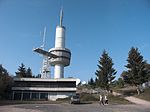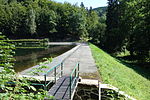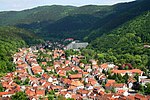Silberhütte was once a village in the formerly free mining town of Sankt Andreasberg in the Harz mountains in Germany, but since its merger on 1 November 2011 it has been part of the borough of Braunlage. The name of the village goes back to the silver works that was existed here until 1912 and which smelted the ores from the mines around Sankt Andreasberg.
According to Ließmann (2003), the smelting of the ores was carried out here soon after the opening of the Sankt Andreasberg silver mines. These naturally had a raised arsenic content. The silver works was located at the confluence of the Wäschegrundbach and the Sperrlutter - so that there was enough water power to drive the machines in the smeltery. Not only did the smelting workers here have to endure toxic emissions but, even in older accounts, there is talk of the massive nuisance caused by toxic, arsenic-containing, fumes from the smeltery which, in unfavourable weather conditions, swept into the town and occasionally forced the people living there to flee.
The first smelting works are recorded at this locality around 1550. At the beginning of the Thirty Years' War, the smeltery was sold and demolished. When the silver mining industry flourished again in the 1680s, a new larger smelting works was built, which - rebuilt and extended several times - was in operation until 1912.
In 1836, the responsible mining authority allowed the construction of a separate arsenic works on the Silberhütte site. In addition to arsenic trioxide, a toxic white powder, arsenic glass was also produced. Handling the powdery poison was very difficult. The workers were only sent into the chimneys to sweep the arsenic with a damp cloth in front of their faces - without a special bonus, hardly any worker was willing to sweep the arsenic dust. A contemporary report by master smelter, Seidensticker, stated that, "the arsenic trioxide produced cannot be weighed because this would cause disproportionately high costs and endanger workers' health more than the rest of the arsenic work put together."








